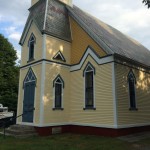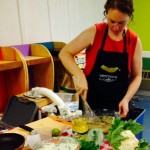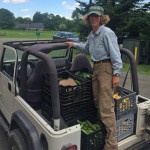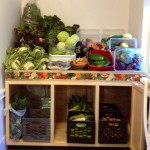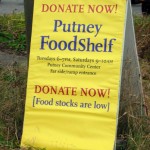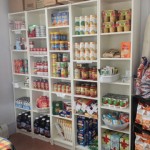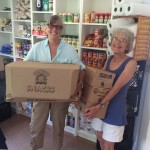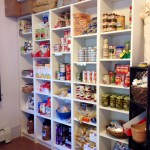This is a guest post from Susan Kochinskas, a volunteer with the Putney Foodshelf. We asked her to provide more info on the Putney Foodshelf, the Putney community and, especially, how they achieved non-profit status recently. Read on…
The Putney Foodshelf was founded in 2005 at the Genesis Church of the Brethren. It moved to the Putney Community Center when the church closed in 2008 and was kept open by two members of Putney Friends Meeting.
The Putney Community Center is right in the village of Putney and has served the community since 1927 with youth programs, dances, rental space for zumba classes, dog training, lectures, and more. It currently houses the Foodshelf and Wildflower Playschool.
The Foodshelf is open Tuesdays 6–7 pm and Saturdays 9–10 am. One does not have to “qualify” or prove need to come to the Foodshelf. No names or records of any kind are needed, and we only ask for the number of people in each household and the zip code so we can document our client need. Putney has a population of around 2,700 and has a wide range incomes: quite wealthy to quite poor. Over 50% of the Putney Central School student population qualifies for free lunch (over 80 students). Anywhere between 20 and 30 individuals walk through the doors of the Foodshelf on a given open hour shopping for their family. A few folks come twice a week, so we are serving perhaps 40+ folks and their families a week plus the additional 10 families we serve through our Family Food Bag program at Putney Central School. (Every Friday we send a bag of groceries for the whole family for the weekend). This translates monthly to food for over 500 individuals (duplicated numbers).
We are incredibly well supported by the community. The bulk of our food comes from the Vermont Foodbank — we had already hauled more than 15,000 pounds into the Foodshelf just in the first 6 months of 2014. Add another 10,000 donated by the community: individuals and groups including Green Mtn. Orchards, Walker Farm, Harlow Farm, Lost Barn Farm, Putney Co-Op, Putney General Store, and all area schools (The Grammar School, Putney Central School, Landmark College, Greenwood School, The Putney School). The Postal Carriers Drive, Stuff the Bus and Project Feed the Thousands have also supported us with food and donations. This translates into over 900 pounds of food moving through the Foodshelf each week. Putney has a caring, giving community.
We currently have over 30 volunteers who work as little as a couple of hours a month to 5 to ten hours a week. We have a Volunteer Coordinator who manages the staffing of our open hours. We are 100% volunteer. All this has grown in the 4 years since those two men were keeping it going after the Genesis Church closed and the Foodshelf moved.
In August of 2010, Transition Putney held a forum on food shelves to help generate more interest, support, and help for the Foodshelf. It was this new group of volunteers who began the nonprofit journey. It was clear the Foodshelf needed an infrastructure not only for keeping its doors open with food and financial donations, but also for long-term sustainability. Annik Paul, an SIT student and Transition Putney intern, took on the Foodshelf as her capstone project. I then looked at how we were housed under the Putney Community Center (PCC) for our nonprofit status and began researching what it took to get our own.
Our mission (as yet unformalized, but obviously about getting food to those who needed it!) was just different enough from the PCC that we felt we needed to separate. We also recognized that if we had to move again for any reason, we would have issues with our status. It wouldn’t impact whether we could still hand out food, but those financial donations are important and people do like to claim the deduction!
There is a lot of good information online about nonprofit status, so I began reading and found a checklist. The majority of the paperwork revolved around the organization’s development and included having a mission statement, goals, objectives, by-laws, roles, responsibilities, policies, and data collection.
We went slowly: the first step was meeting on a regular basis and documenting agendas and minutes. Since our volunteer group had grown, we needed that opportunity to meet and talk about what we were doing and how we were doing it. Our meetings that first year happened (almost) monthly and were attended by anywhere between 2 to 10 people. We realized pretty quickly that we needed a steering committee to keep us organized, share the work and responsibilities, and track information. We decided to house all of our paperwork and information online for archival and transparency reasons (We use a Drop Box and all have access to it.) I was very aware that if we did not do this and lost a valued volunteer, we would lose “how to” information and historical data as well (which one always needs for grant work). It helped in writing this article to go back and reread minutes and realize just how far we have come!
We held our first annual meeting in January of 2012. We had been meeting monthly for 6 or 7 months with short, concise meetings. At our annual meeting (a planning meeting lasting several hours), we wrote our mission statement: “The Putney Foodshelf provides supplemental healthy food for area people in need.” We made the decision to formally work on our own 501(c)(3) status and formed a subcommittee to begin that work. That group of three met monthly reporting back to the more general meetings on progress. Again, we moved slowly.
In April, one of the committee announced she had found a lawyer, pro bono, who would help review our paperwork when we were ready. Bylaws were still being working on. The easiest way to create bylaws was to ask other like agencies for theirs. Much of the subcommittee work was going through these line by line and figuring out what would work best for us. There was other paperwork that needed to be done as well and we were working off that checklist I had found online.
Once finalized, the Bylaws were presented to the whole group in September 2012. A few changes were made and then accepted by the group. With the acceptance of the Bylaws, the next step was electing officers.
While all of this non profit status work was going on, we were tightening up other rules and ways of doing things. Always a seat-of-the pants kind of operation, we dealt with issues as they arose (and still do!).
The Putney Foodshelf has always had an incredible volunteer group. No one person dictated who did what and each person found their niche and did it well. The board was elected without much chatter. It didn’t really mean any different work for anyone elected…each of us were already doing much of that same work. Once we had our Bylaws and officers, we filed our articles for incorporation with the state of Vermont.
Next we began working on the application paperwork required for 501 status. We took our time and chipped away at it regularly, but it was not until spring of 2013 that we were ready to present it to our lawyer for review. He answered questions we had and suggested some corrections. We sent off the completed paperwork (and check!) in August of 2013. We heard back pretty quickly — we had not sent in the proper amount of money! At least we knew they had received our application! Within two months we received notification that they had everything and would be submitted for review. It took us almost 2 years to get to this point. The wait began! I called the IRS in January 2014 just to be sure we were in line to be reviewed. They checked the number I had on the letter and was told they would be in touch.
We heard in July of 2014 that we had received nonprofit status. Hooray!
Does it change what we do day-to-day? No. But it gives us credibility.
Now we can separate from the PCC financially but not physically. The Putney Community Center has provided the Foodshelf space and utilities and acted as its fiscal agent since 2008. Although we feel challenged by our little space, the PCC is a good fit and location for a food pantry. As both groups evolve to tighter organizations we are looking at a lease/rental agreement. Both the Foodshelf and the Community Center need to show long-term commitment to the building and the viability of the space.
The biggest tip I suggest to any group looking to get their own nonprofit status is to take your time. Each of us were so busy with our own full-time employment plus our volunteer commitment to the Foodshelf, to add even more work (and it is daunting!) could really stress one out! But if you look long-term and chip away at the to-do list slowly, before you know it you are ready to file. “Borrow” and adapt others bylaws. This saved us considerable time. Why reinvent the wheel? It already works!
The work needed for all of this helped us tighten up our financial planning and budgeting. By electing officers and creating job descriptions, we have become a better run outfit. And with forethought on archiving of information (agendas and minutes), budgets, how-tos on all our jobs, policies and data collection, we have built a legacy so that the Foodshelf can continue without any one of us and continue to serve our neighbors in need as long as there is hunger in our community.


